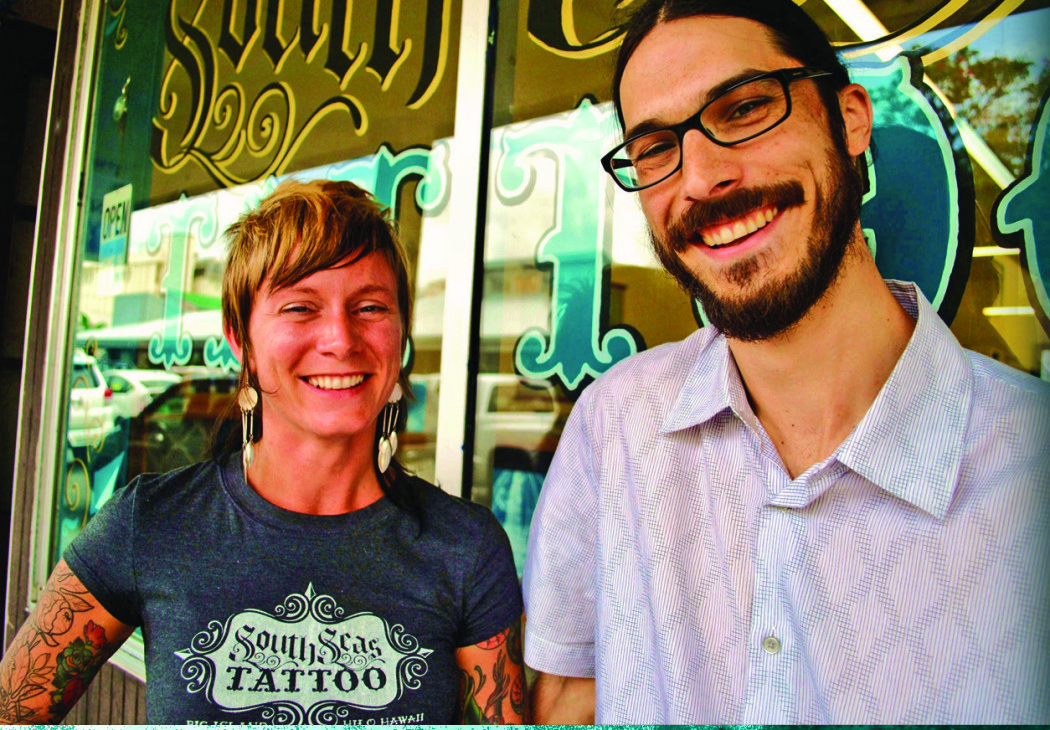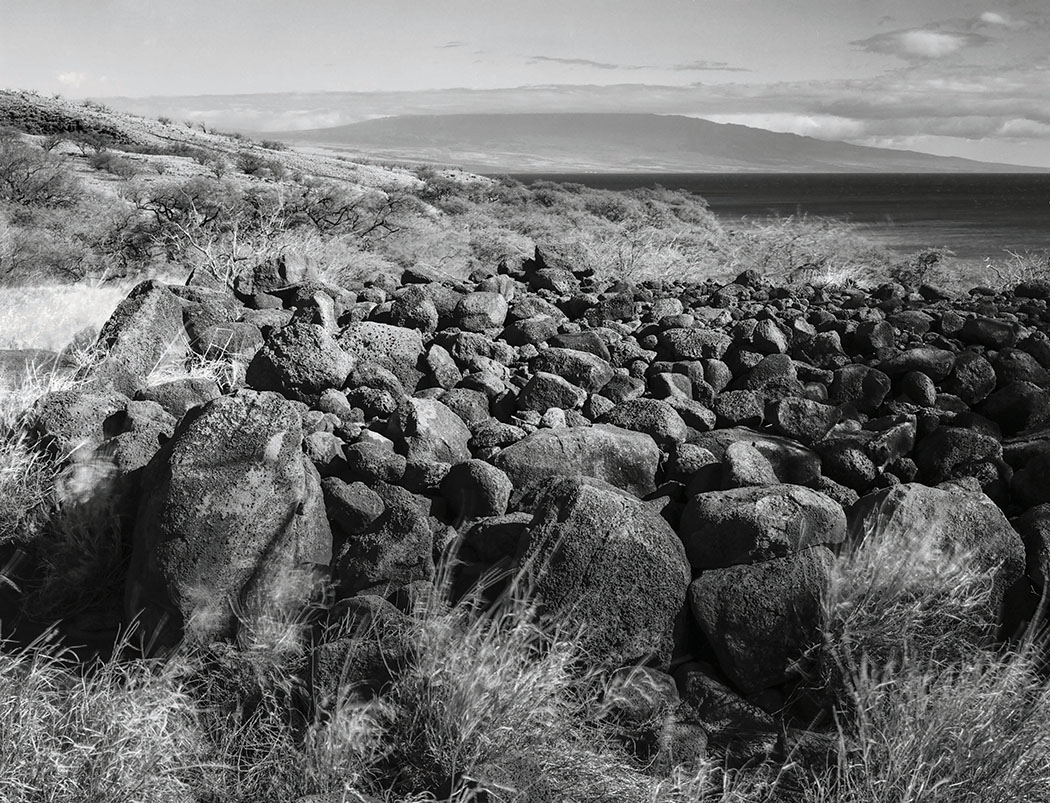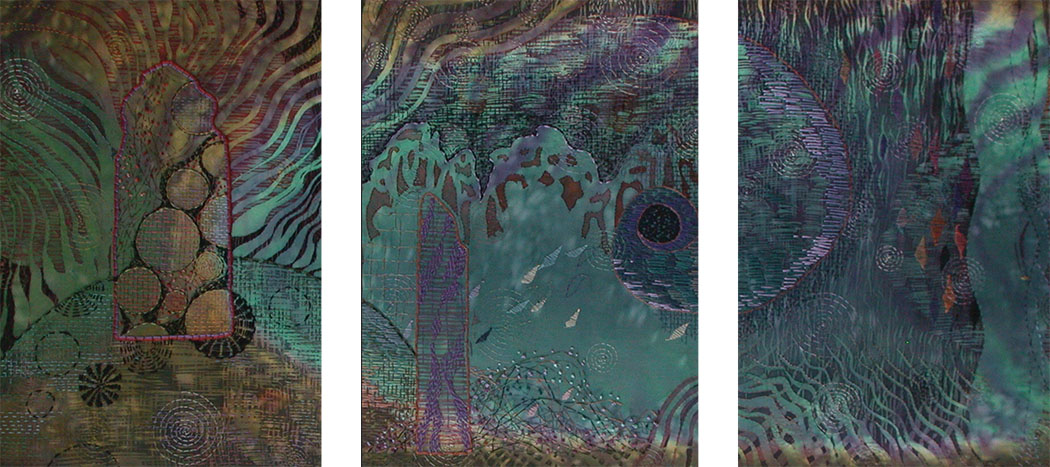
Marked Teachings: Tattoo as Transformative Art
 By Jessica Kirkwood
By Jessica Kirkwood
The tattoo is not just a form of art, but a sacred
dance in symbolic healing. Marked in momentum, the
rhythm beats fast from the coiled snake. Journeying,
thoughts come forth from the void. Let them go.
Fear not the acceptance of others, but seek to know yourself,
for alone you will discover your true nature and the symbols
you carry with heart. – Kevin Bays
Nearly two years after the sudden passing of their friend and forever mentor, Kevin Bays, Kristin Lowery and Simon Gentry reveal how they turned an unfortunate tragedy into a form of healing and creative triumph. “Now I can look back and see that it’s fitting he died dancing. It’s very reflective of who he was,” reveals Kristin. And so this is the story of how a tattoo artist’s legacy has been deliberated through the hearts and hands of his two most devoted students.
With paintings hanging in the esteemed Hilton Waikoloa and the Chase & Hanes Gallery in Hilo, Simon Gentry was still desperately seeking to expand his creative potential. So in 2004, after five years on the Big Island, and with no firm ties grounding him to this locale, his next destination would be Alaska and beyond.
Nearing his last days as a cashier at Hilo Bayfront’s Abundant Life, a gentle, extremely tattooed man came through his till, and introduced himself as Kevin. A brief conversation over organic goods allowed them just enough time to link into a coincidental affiliation; they were both from Kansas and were both fine arts majors.
“We hit if off immediately,” admits Simon, “he was looking for an apprentice, and so I brought him my portfolio.”
Although Simon had not a single tattoo on his body at the time, it was because of this chance meeting that he chose to stay in Hilo.
If it is meant to be, let the Universe provide the opportunity to make the connections that are necessary—to pollinate the evolution of thought. Not random, but it used to seem that way. It’s always a surprise. Now I am a magnet—creating the environment, attracting abundance, fueling positive relationships. – Kevin Bays
Just a few months later, Kristin Lowery wandered into the shop where Kevin worked, in search of an artist to give her a small, weathered bottle containing a script inside—a message in a bottle, symbolizing her newly-discovered awakenings since moving to the Big Island. She immediately took a liking to Kevin’s portfolio.
“I remember we were wearing the same straw fedora hat,” she smiles.
Over the following few months, between engaging coffee talks and trips to the ocean, Kristin and Kevin’s friendship evolved into a romance. Upon repeatedly hearing about Kevin’s newest friend and apprentice, Simon, Kristin jokingly (and with a big hint of sincerity) asked when she too could apprentice with him.
“Kevin said he thought I’d never ask,” recalls Kristin, “he was just waiting for me to say the words.”
Kevin’s time became divided between guiding Kristin, tucked among the trees along Puna’s Red Road, and teaching Simon the skills, techniques and aesthetic possibilities of his trade in Hilo. Both Kristin and Simon were given the opportunity to watch Kevin in his element, and said they began realizing that there was a whole other dimension to tattooing that they were just beginning to understand.
A popular art amongst sailors and slaves, and kings to commoners, the ancient practice of tattoo was once used to smuggle secret messages across enemy lines and has even been discovered on olden mummies.
Traditional tattoos in old Hawai’i used an ink created from ground kukui nuts and sugarcane juice. Ritual needles were bird claws, beaks and fish bones that were tied to sticks and struck with a mallet to puncture the skin.
The art was eventually introduced to the West by Captain James Cook during his 1769 voyage to the South Pacific, and in 1777 the word was put into the English dictionary. From the Hawaiian ‘kakau’ and the Tahitian ‘tatau’, meaning ‘to mark,’ the word has also been suggested to be onomatopoeic in nature, with ‘tat’ referring to the tapping of the instrument on the skin and ‘au’ the voiced reaction from the person being marked!
To the ancient Hawaiians, tattoos were used for many reasons, one of which was to identify individuals, linking them to a specific tribe and family. Another was for warriors to look savagely fierce and to frighten their opponents in battle. Slaves, the lowest level in the Hawaiian kapu system, were marked with a single line across the bridge of their noses. Often, the designs had hidden and personal meanings that weren’t readily apparent to passersby.
Kristin, previously a graphic designer from Chicago, eventually purchased her own equipment and began inking her friends in Puna.
“I got to tattoo and bond with my ‘ohana, and then watch many places in each person heal,” she says. “It’s an honor to participate with someone in that process.”
Oddly enough Kristin and Simon pretty much passed each other by, having met only briefly on a few occasions. However, it didn’t take long for either of them to realize that Kevin was not merely teaching them the art of design, print, and skin, but slowly, and without force, the art of living, too.
“I always had serendipitous moments when I was around him,” reflects Simon, “He was a visionary. He was constantly looking for signs and symbols around him. He even studied his dreams.”
Kevin Bays was a Buddhist practitioner and a reverend. And although he studied the philosophies, religions, prophecies and divinations of many diverse cultures, he connected most to the spiritual teachings of the Native American Indian Church—namely to the sacred Medicine Wheel. The Medicine Wheel teaches that all lessons are equal; as are all talents and abilities, and that each spoke is experienced by every living creature. Just as the rotation of the planets, moons, and galaxies, even the changing of the seasons, the circle is continuous—it is never ending. It signifies life without end. Kevin spent a generous amount of time volunteering at Native American churches in Los Angeles, where he studied the Wheel with great veneration and detail. The Wheel eventually brought him to study the symbolic and healing art of tattoo.
“Kevin trusted in the Universe and believed that everything happens as it should,” says Kristin. “He reminded me that I was given the tattoos that I was meant to do.”
Kevin eventually gave Simon his first tattoo. Suitably, it was a small yellow Western Meadowlark, the state bird of Kansas, signifying their mutual connection to their homeland. His second tattoo, again given by Kevin, would be an i’iwi, or honeycreeper – the state bird of Hawai’i.
Change our vocabulary, our mindset, our habits, and thus change our world. And among this we may even attract exactly what we need for growth, maybe someone that shares many of our same ideals and gives us the reflection we need to see more about who we are and how we define ourselves. – Kevin Bays
Everything was flowing well until simultaneously and without warning, Simon and Kristin’s worlds came to a crashing halt. Surrounded by close friends and community members, Kevin passed away suddenly and very unexpectedly due to a rare, genetic heart condition while dancing at the Palace Theatre in Hilo on January 10, 2010. He was 36 years old.
“I spent a good chunk of time in shock. My friends took care of me. They brought me meals over the following weeks,” said Kristin.
Eventually, with patience and time by her side, Kristin admits to experiencing unusual freeing sensations following some of her lengthiest bouts of sorrow—moments when her grief was suddenly eclipsed by a liberating gratitude that the depth of suffering was finally beginning to subside. These moments began revealing to her a more expansive trust in life itself.
“I had a general feeling of the Universe opening up,” she recalls.
Simon was abroad at the time of Kevin’s memorial, and although he didn’t learn about his friend’s passing until after he arrived back in Hawai’i, he almost immediately began tattooing customers that Kevin had not yet completed. “Finishing the tattoos that Kevin had started was definitely a big part of my grieving process.”
Emotions do not make us weak, but make us more whole. If we deny any aspect of ourselves then we deny our true potential. – Kevin Bays
As tattoo artists, both Kristin and Simon recognize that clients often come in with a design, tied to some personal meaning, but understand that, more often than not, the true meaning reveals itself in the days and months following the tattoo.
“The tattoo itself has a way of transforming you,” says Simon.
“By putting something on top of your skin, you’re revealing more of what is underneath it,” adds Kristin.
The two maintain that Kevin’s death was much like the process of receiving a tattoo. “I didn’t really understand his teachings until after he died,” says Kristin, “His whole philosophy was of trusting in the Universe and trusting the process. And I was pushed into really understanding and living these lessons. I don’t think I could have understood them otherwise.”
One of Simon’s more recent tattoos entitled “For the Sun,” is a beautifully detailed design with a history tied to the Native American Church. Applying the tattoo to his own body, it circulates with bright, moving colors, and is a fantastic example of not only his remarkable talent, but his heartfelt approach to his art.
“It represents Kevin’s place in my life,” he says, “I believe he has ascended to the next realm and is now achieving higher enlightenment. I want to honor this knowing.”
Tattooing was an integral part of mourning among Pacific Island cultures. In the Marquesas, New Zealand and in Hawai‘i, the names of the deceased were often inscribed on the body as a sign of grievance. Upon the death of Kamehameha the Great in 1819, several Hawaiians tattooed his name and date of death on their bodies as a symbol of respect and loyalty. A practice that is still apparent today. Hawai’i’s Queen Kamamalu had her tongue tattooed as an expression of sorrow when her mother-in-law passed away. When missionary William Ellis inquired about the pain she had undergone while receiving the tattoo, her reply was, “Ha eha nui no, he nui roa ra ku’u aroha,” meaning, “Great pain indeed, greater is my affection.”
Although healing was finally taking form for Kristin and Simon, still they found themselves at a rather daunting roadblock. What would they do now that Kevin was gone? They decided to join forces.
At first they met over dinner, bonding over Kevin’s death. Then their meetings soon evolved in to a full-blown action plan. Their shared scar tissue became a catalyst for growth. They maintain that having Kevin as their teacher was an honor and a blessing, and that opening their own shop, “South Seas Tattoo,” was a large part of their coping process.
“Even in his death he is still our mentor,” says Simon. When we can’t decide on something, we say, ‘What would Kevin do?’ We constantly keep his spirit alive.”
Each step, whether good or bad, is still a step forward. Lessons to be learned. Possessions to be renounced. The shedding of assumptions like the shedding off of skin and hair. The little deaths we live each day leading us to new births, the cycle continues. – Kevin Bays
Kevin came into their lives at about the same time, and then left them both with an art form that is now their all-consuming passion. His guidance gave them the freedom to discover their own inclinations and talents, and to fashion their innermost pleasures. While at the same time, their sorrow over his death allowed them to regard the future not as frightening, but as a product of their own strengths and abilities.
“His passing thrust us both into maturity and professionalism,” discloses Kristin.
Signing their company’s business license on the one-year anniversary of Kevin’s passing, they even had a beautiful ceremony devoted to him on the opening day. Kristin hosted a successful art show in memory of Kevin, entitled “Through the Illusion,” on the grounds of Kalani Honua retreat in Puna. It featured the works of 40 artists, including Kevin’s own insights, art and poetry.
The less I hang on, the freer I become. The freer I become, the more space I provide. The more space I provide, the more room there is for spirit. For all things are but a creation within my own imagination. The people, the noise of murmur, murmur… the trees and flowers, mountains and ice, the cool breeze that kisses my cheek on a hot day. I am thankful. This is my song. Can you hear it in the thunder? – Kevin Bays
After sharing time with the humble and soft-spoken tattooists, I have a renewed respect for the power and propensity of what it means to heal – from the outer skin to the innermost parts of our being. I am reminded that we cannot evade our life’s course, which often includes deep and painful places, but we can courageously look upon these darker places, and see the fortune, the color, and the creativity, in our pain and sufferings most brilliant awakenings. ❖
Contact writer Jessica Kirkwood: jkirkwood23@hotmail.com
Website: southseas-tattoo.com


